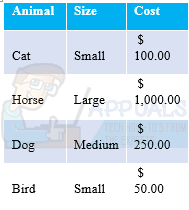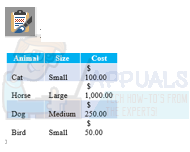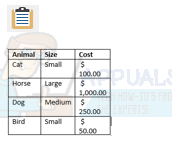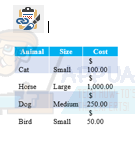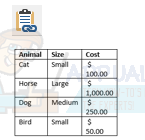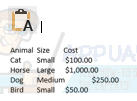Let’s say that you need to make a table and send it to someone in an email. You could try and do this in outlook; it would however take some additional time to format to ensure it looks right. So, when you think of a table you probably envision Excel. Look at the below table created in Excel. This has been copied from Excel and pasted directly into this article using your standard paste operation. Without seeing the original Excel table, you might think this doesn’t look to bad. What you don’t see is that the cell values are supposed to be centered vertically and horizontally. The cost column looks slightly off as well; in fact, I’m pretty sure that is now how we denote currency (above the amount). So, what does the table actually look like?
That looks slightly better in my opinion. This solution however may not work for what you need. We are going to briefly describe the various solutions for pasting and resolving data from Excel in other solutions.
How to resolve formatting issues when copying from Excel
Using the same examples as above, let’s see what solutions we have for this. First, what are our options when we paste data?
From left to right we have:
Keep Source Formatting
Keep Source Formatting is your default paste option. Usually this will work as expected but it depends on how the data is formatted from the source. In this example the source formatting includes the “Accounting” style which isn’t recognized by Outlook and many other applications. Changing the style to “Currency” would allow you to paste using Keep Source Formatting and it would look better.
Use Destination Styles
If you want to use formatting that is like other text in the destination, then use this paste option. It will still keep general formatting like bold and italicize but will use the destination styles such as font style and size.
Link and Keep Source Formatting
This will keep the source formatting as is and will keep the table linked to its original source. There is some additional functionality for this but it allows the person you are sending data to click “Update Link” by right clicking on the table and receive updates. This of course would need to be configured properly to work as described.
Link and Use Destination Styles
Link and Use Destination Styles works the same as Link and Keep Source Formatting except this will use the destination formatting. Things like color are not updated after initially copied over but text changes to the data will be updated.
Picture
Picture can be useful if you are just wanting to show the data and no longer require the need to format, edit or receive updates from it. Pasting as a picture will ensure the image looks identical to the source. But your party will not be able to modify it so make sure this is applicable for your solution.
Keep Text Only
Keep Text Only will display the table as it was, but in text form. There will not be a formatted table present nor any formatting other than your destination formatting styles like size and font style. There are of course other ways to use the above pasting styles and modify the result to look how you want it to. A quick example; by slightly modifying the width of the “Cost” column in outlook using the Keep Source Formatting pasting style the formatting now looks correct and keeps the Accounting format set on the cost column. The best way to learn is to play with the above pasting styles and see how they best fit your needs.
FIX: Cannot Preview EXCEL Files in Outlook 2016Fix: Outlook 2016 Freezes When Previewing Excel FilesFix: Data Source References is Not Valid in ExcelHow to Import Data from PDF to Excel
